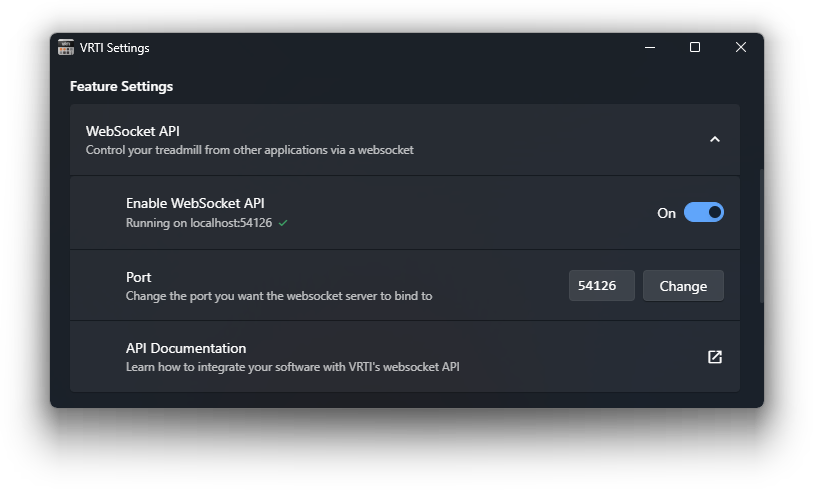Using the API
In order to enable external programs to interact with your Treadmill, VRTI offers a websocket API that the user can enable.
Configuration
The Websocket API can be enabled within VRTI’s settings.
By default, the websocket API is exposed on port 54126. This port can be changed by the user within the settings dialog.

Message Formats
Command Format
Commands are sent to VRTI to perform various actions. Every command should be a JSON object with the following properties:
| Property | Value Type | Description |
|---|---|---|
command | string | The command to run |
payload * | string | The command specific payload for the specified command. This should always be a valid JSON value. |
refId * | string | A unique identifier for the command. This identifier will be returned in any response event if you specify it. |
| * Optional |
See the Command Reference for a list of available commands.
Some commands will return a response, which will be sent like any other event. Unlike other events, clients do not have to subscribe to these response events to receive them.
Event Format
Events are sent by VRTI to connected clients.
Event messages are only sent for the specific events that the client has subscribed to. For events that are sent as a response to a command, clients do not have to subscribe to receive them.
To subscribe to an event, send a EventSubscribe command for each event you want to receive messages for.
Every event is a JSON object with the following properties:
| Property | Value Type | Description |
|---|---|---|
event | string | The name of the event |
payload * | string | The event specific payload for the specified event. This is always a valid JSON value. |
refId * | string | If this event is a response to a command for which a refId property was specified, this property will be set with the same value. |
| * Optional |
See the Event Reference for a list of available events.
Connecting to the WebSocket
A TypeScript example of how to connect to the WebSocket API in NodeJS is shown below.
While these examples are written in TypeScript, you can apply the same concepts to any other languages that support WebSockets.
// Construct the WebSocket object and connect to VRTI's WebSocket.const socket = new WebSocket("ws://localhost:54126");
socket.addEventListener("open", (event) => { // We are now connected to VRTI's WebSocket API console.log("Connected to VRTI");});Sending a command
Once you are connected to VRTI’s WebSocket, you can send commands to VRTI to perform various actions.
Below you will find an example of how to send a command that starts a treadmill by setting its target speed to 5.0 km/h.
// Construct the message for the commandconst message = { command: "SetTargetSpeed", payload: "5.0"};// Convert the message to a JSON string and send it over the WebSocketsocket.send(JSON.stringify(message));See the Command Reference for a full list of available commands.
Subscribing to events
To receive events from VRTI, you need to subscribe to them (with the exception of events sent as a command response).
To subscribe to an event, you need to send the EventSubscribe command with the events you want to receive:
// Subscribe to the TreadmillStateUpdated and AutoWalkSettingsUpdated eventsconst message = { command: "EventSubscribe", payload: JSON.stringify(["TreadmillStateUpdated", "AutoWalkSettingsUpdated"])}; socket.send(JSON.stringify(message));See the Event Reference for a full list of available events you can subscribe to.
Once you have subscribed to an event, you will receive messages for that event as they occur:
socket.addEventListener('message', (event) => { // Parse the incoming message const message = JSON.parse(event.data); // Check if it's a TreadmillStateUpdated event if (message.event === 'TreadmillStateUpdated') { // If so, parse its payload and log it const payload = JSON.parse(message.payload); console.log('Treadmill State Updated:', payload); }});Treadmill State Updated: { connected: true, running: true, currentSpeed: 1.89, targetSpeed: 2, userSpeedLimit: 7.5, deviceSpeedRange: { min: 0.5, max: 10, step: 0.1 }, stepsSupported: false, distanceSupported: false}